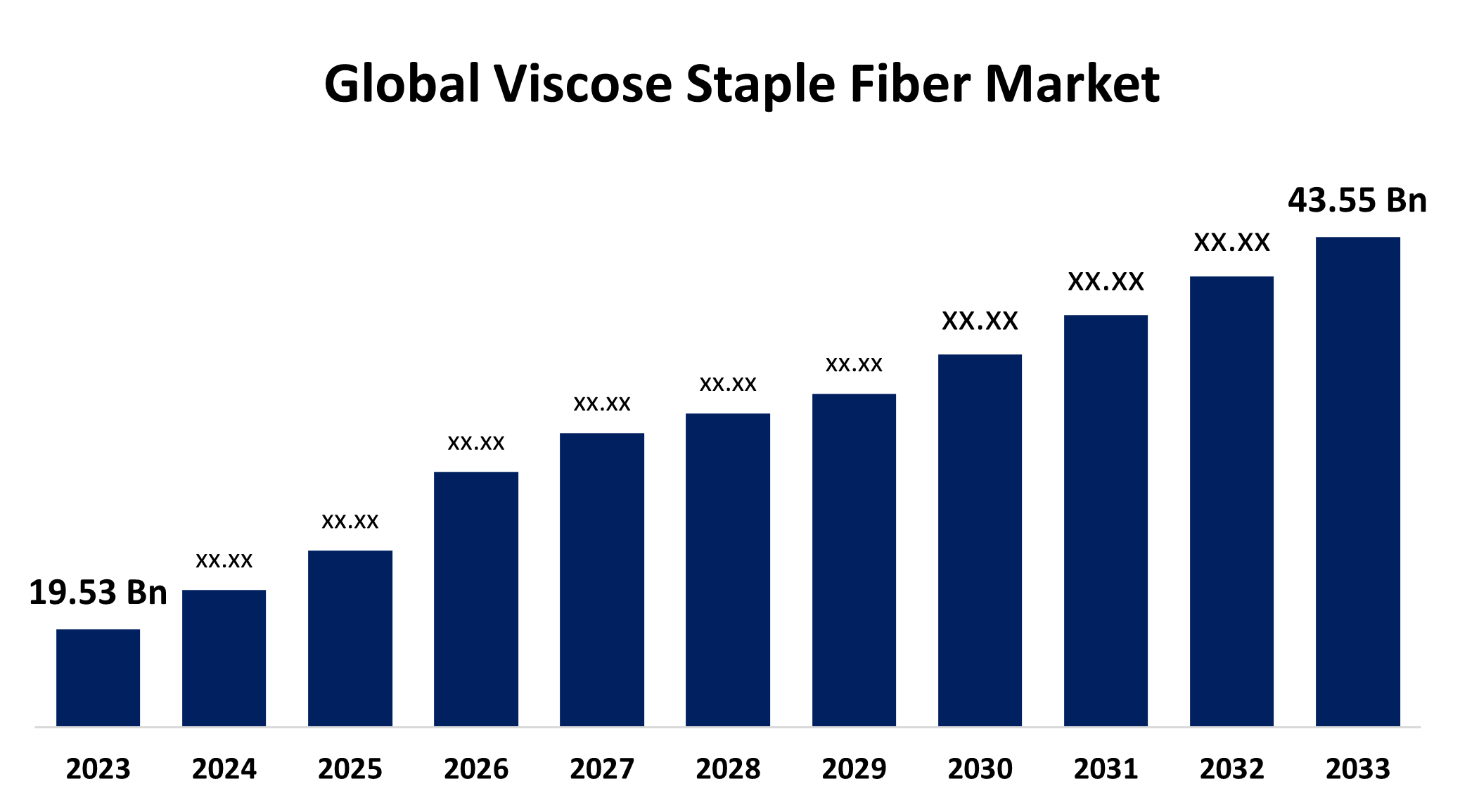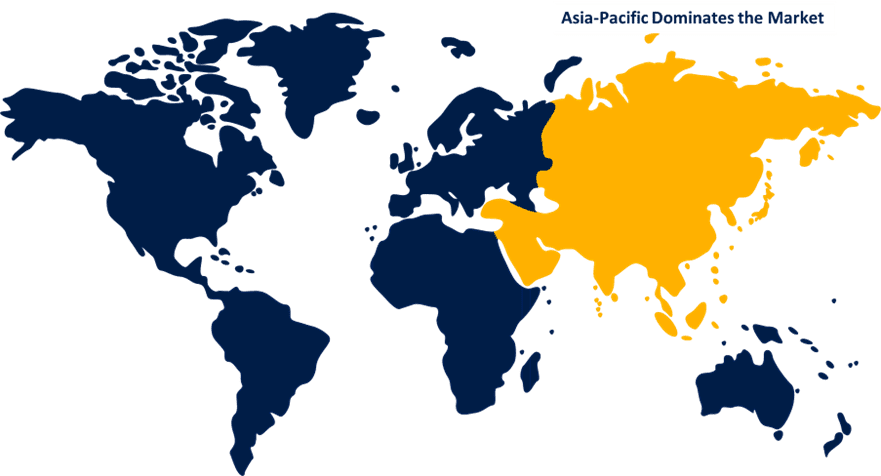Global Viscose Staple Fiber Market Size, Share, and COVID-19 Impact Analysis, By Type (High Wet Modulus Fiber, Strong Fiber, Modified Fiber, and Others), By Application (Woven, Non-woven, and Specialty), By End-Use Industry (Textile Apparels, Healthcare, Automotive, and Others), and By Region (North America, Europe, Asia-Pacific, Latin America, Middle East, and Africa), Analysis and Forecast 2023 - 2033.
Industry: Chemicals & MaterialsGlobal Viscose Staple Fiber Market Insights Forecasts to 2033
- The Global Viscose Staple Fiber Market Size was Estimated at USD 19.53 Billion in 2023
- The Market Size is Expected to Grow at a CAGR of around 8.35% from 2023 to 2033
- The Worldwide Viscose Staple Fiber Market Size is Expected to Reach USD 43.55 Billion by 2033
- North America is Expected to Grow the fastest during the forecast period.

Get more details on this report -
The Global Viscose Staple Fiber Market Size is projected to reach USD 43.55 Billion by 2033, Growing at a CAGR of 8.35% from 2023 to 2033. The growing adoption of viscose owing to the awareness about the environmental impact of synthetic fibers and preference for sustainable and eco-friendly materials are driving the market for viscose staple fiber.
Market Overview
The viscose staple fiber market refers to the market for artificial cellulose fiber used to make clothing, home textiles, and other consumer goods. Viscose staple fibers (VSF) are biodegradable cotton-like fibers, made from wood pulp and cotton pulp, widely used for manufacturing apparel, home textiles, dress materials, knitted wear, and non-woven applications. Further, the automotive industry uses fabrics and textiles in various applications such as carpets, interior trim & headliners, textile reinforcement in composite parts, and exterior textile parts. VSFs are increasingly used for closed-loop production since they can be recycled and used again to create new textiles. The circular economy in the fashion industry is at the forefront of closed-loop production using recycled viscose. The growing popularity of athleisure, loungewear, and eco-conscious fashion are providing market opportunities for viscose staple fiber.
Report Coverage
This research report categorizes the viscose staple fiber market based on various segments and regions forecasts revenue growth and analyses trends in each submarket. The report analyses the key growth drivers, opportunities, and challenges influencing the viscose staple fiber market. Recent market developments and competitive strategies such as expansion, type launch, development, partnership, merger, and acquisition have been included to draw the competitive landscape in the market. The report strategically identifies and profiles the key market players and analyses their core competencies in each sub-segment of the viscose staple fiber market.
Global Viscose Staple Fiber Market Report Coverage
| Report Coverage | Details |
|---|---|
| Base Year: | 2023 |
| Market Size in 2023: | USD 19.53 Billion |
| Forecast Period: | 2023 – 2033 |
| Forecast Period CAGR 2023 – 2033 : | 8.35% |
| 023 – 2033 Value Projection: | USD 43.55 Billion |
| Historical Data for: | 2019-2022 |
| No. of Pages: | 246 |
| Tables, Charts & Figures: | 102 |
| Segments covered: | By Type, By Application, By Regional Analysis, By End-Use Industry and COVID-19 Impact Analysis. |
| Companies covered:: | Sateri Holdings Limited, Grasim Industries Limited, LENZING Group, Xinjiang Zhingtai Chemical Co., Ltd., Asia Pacific Rayon Limited, Birla Cellulose, Glanzstoff, Liaoyuan Hengtai Fiber, Dangjin Semiconductor Materials, Tangshan Sanyou Group Xingda Chemical Fiber Co. Ltd., Kelheim Fibers GmbH, Kayavlon Impex Pvt. Ltd., and Other Key Vendors. |
| Pitfalls & Challenges: | COVID-19 Impact, Challenges, Future, Growth, & Analysis |
Get more details on this report -
Driving Factors
The rising demand for viscose staple fiber in the textile industry due to its versatility and sustainability is driving the market demand. The increasing consumer spending on clothing and other textile products along with the increasing disposable income in emerging economies are contributing to propel the viscose staple fiber market. The increasing environmental awareness and government support for sustainable industries are significantly contributing to promoting the viscose staple fiber market.
Restraining Factors
The environmental challenges associated with the VSF production process which include high energy consumption, water pollution, deforestation, and overuse of chemicals are hampering the global viscose staple fiber market.
Market Segmentation
The global viscose staple fiber market share is classified into type, application, and end-use industry.
- The strong fiber segment dominated the viscose staple fiber market with the largest market share in 2023 and is anticipated to grow at a significant CAGR during the forecast period.
Based on the type, the viscose staple fiber market is classified into high wet modulus fiber, strong fiber, modified fiber, and others. Among these, the strong fiber segment dominated the viscose staple fiber market with the largest market share in 2023 and is anticipated to grow at a significant CAGR during the forecast period. Strong fiber is a durable, biodegradable fiber, often used as a substitute for cotton, made from wood pulp. The increasing preference for these fibers in the production of textiles and clothing for residential, commercial, and medicinal uses is driving the market.
- The woven segment dominated the market with the largest market share in 2023 and is anticipated to grow at a significant CAGR through the forecast timeframe.
Based on the application, the viscose staple fiber market is classified into woven, non-woven, and specialty. Among these, the woven segment dominated the market with the largest market share in 2023 and is anticipated to grow at a significant CAGR through the forecast timeframe. Viscose staple fiber is used in woven fabrics for clothing, home textiles, and other applications. The affordability, lightness, and sturdiness of woven viscose staple fiber are driving the market in the woven segment.
- The textile apparels segment dominated the market with the largest market share in 2023 and is expected to grow at a significant CAGR during the forecast period.
Based on the end-use industry, the viscose staple fiber market is classified into textile apparels, healthcare, automotive, and others. Among these, the textile apparels segment dominated the market with the largest market share in 2023 and is expected to grow at a significant CAGR during the forecast period. Fabrics made using viscose staple fibers (VSF) are soft, pleasant, extremely absorbent, wrinkle-free, and reasonably priced. VSFs are used extensively in the production of clothing. The industry’s growing need for comfortable clothing is anticipated to fuel the market expansion.
Regional Segment Analysis of the Viscose Staple Fiber Market
- North America (U.S., Canada, Mexico)
- Europe (Germany, France, U.K., Italy, Spain, Rest of Europe)
- Asia-Pacific (China, Japan, India, Rest of APAC)
- South America (Brazil and the Rest of South America)
- The Middle East and Africa (UAE, South Africa, Rest of MEA)
Asia Pacific is anticipated to hold the largest share of the viscose staple fiber market over the predicted timeframe.

Get more details on this report -
Asia Pacific is anticipated to hold the largest share of the viscose staple fiber market over the predicted timeframe. Viscose fibers are widely manufactured in China and India, and the fast industrial growth in these developing nations is expected to propel the region’s market expansion. The regional market is further being driven by China's numerous sectors' need for sophisticated textiles. In addition, the demand for viscose staple fiber from the automotive and construction industries is propelling the market.
North America is expected to grow at the fastest CAGR growth of the viscose staple fiber market during the forecast period. The increasing product demand from automotive and textile applications as well as the rising need for essential products like clothes and hygiene products are propelling the viscose staple fiber market. Further, the adoption of sustainability and demand for automotive textiles are contributing to driving the regional market growth.
Competitive Analysis:
The report offers the appropriate analysis of the key organizations/companies involved within the viscose staple fiber market along with a comparative evaluation primarily based on their type of offering, business overviews, geographic presence, enterprise strategies, segment market share, and SWOT analysis. The report also provides an elaborative analysis focusing on the current news and developments of the companies, which includes type development, innovations, joint ventures, partnerships, mergers & acquisitions, strategic alliances, and others. This allows for the evaluation of the overall competition within the market.
List of Key Companies
- Sateri Holdings Limited
- Grasim Industries Limited
- LENZING Group
- Xinjiang Zhingtai Chemical Co., Ltd.
- Asia Pacific Rayon Limited
- Birla Cellulose
- Glanzstoff
- Liaoyuan Hengtai Fiber
- Dangjin Semiconductor Materials
- Tangshan Sanyou Group Xingda Chemical Fiber Co. Ltd.
- Kelheim Fibers GmbH
- Kayavlon Impex Pvt. Ltd.
- Others
Key Target Audience
- Market Players
- Investors
- End-users
- Government Authorities
- Consulting And Research Firm
- Venture capitalists
- Value-Added Resellers (VARs)
Recent Developments
- In May 2023, Kelheim Fibres GmbH and Santoni Spa jointly developed an innovative and sustainable menstrual underwear garment based on advanced machine technology and high-quality performance viscose fibres.
- In November 2022, Lenzing – Lenzing Group, a leading global producer of wood-based specialty fibers, is celebrating a key milestone as the production of LENZING ECOVERO branded viscose fibers reaches over 300,000 tons since the brand’s inception in 2017.
Market Segment
This study forecasts revenue at global, regional, and country levels from 2023 to 2033. Spherical Insights has segmented the viscose staple fiber market based on the below-mentioned segments:
Global Viscose Staple Fiber Market, By Type
- High Wet Modulus Fiber
- Strong Fiber
- Modified Fiber
- Others
Global Viscose Staple Fiber Market, By Application
- Woven
- Non-woven
- Specialty
Global Viscose Staple Fiber Market, By End-Use Industry
- Textile Apparels
- Healthcare
- Automotive
- Others
Global Viscose Staple Fiber Market, By Regional Analysis
- North America
- US
- Canada
- Mexico
- Europe
- Germany
- UK
- France
- Italy
- Spain
- Russia
- Rest of Europe
- Asia Pacific
- China
- Japan
- India
- South Korea
- Australia
- Rest of Asia Pacific
- South America
- Brazil
- Argentina
- Rest of South America
- Middle East & Africa
- UAE
- Saudi Arabia
- Qatar
- South Africa
- Rest of the Middle East & Africa
Frequently Asked Questions (FAQ)
-
1. What is the CAGR of the viscose staple fiber market over the forecast period?The viscose staple fiber market is projected to expand at a CAGR of 8.35% during the forecast period.
-
2. What is the market size of the viscose staple fiber market?The Viscose Staple Fiber Market Size is Expected to Grow from USD 19.53 Billion in 2023 to USD 43.55 Billion by 2033, at a CAGR of 8.35% during the forecast period 2023-2033.
-
3. Which region holds the largest share of the viscose staple fiber market?Asia Pacific is anticipated to hold the largest share of the viscose staple fiber market over the predicted timeframe.
Need help to buy this report?